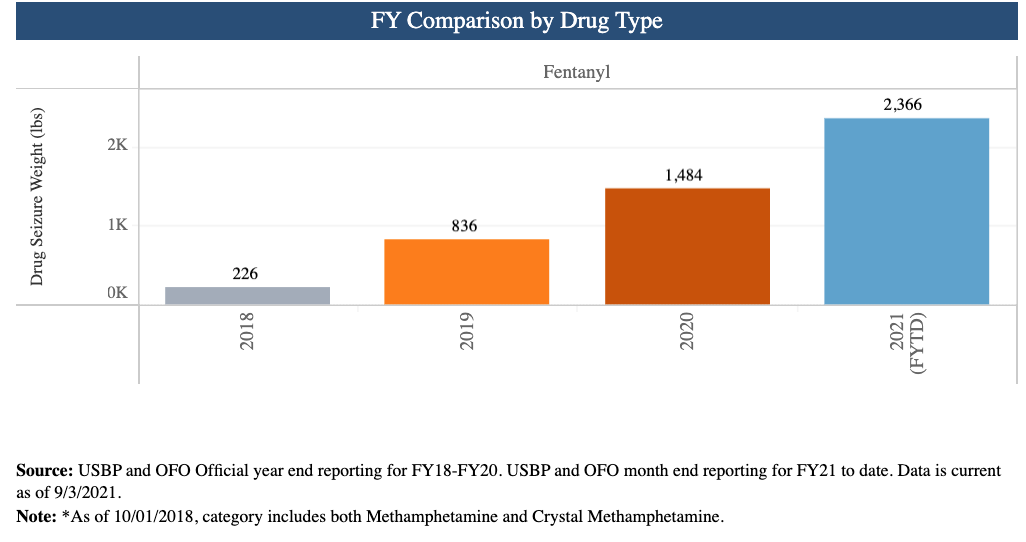MCALLEN, Texas — More teenagers in one Arizona border county are dying from fentanyl overdoses than from car crashes, suicide, or the coronavirus, according to the governor.
The surge in fentanyl-caused deaths in people under age 20 in Pima County, Arizona, is an indicator of how widely available fentanyl has become in the county, which includes the city of Tucson and runs along 100 miles of the U.S.-Mexico border.
“This is our reality. Fentanyl overdoses have replaced car accidents as the leading cause of death for people 19 and younger in Pima County,” Gov. Doug Ducey, a Republican, said while speaking to reporters in Mission, Texas, on Wednesday. “Pima County deputy sheriffs are responding to a call involving fentanyl every 40 hours.”
Anthony Gimino, spokesman for the Pima County Health Department, confirmed to the Washington Examiner that fentanyl is the leading cause of death in people 19 years old and younger, adding that 18 people have died in 2021.
In total this year, 140 Pima County residents have died as a result of a fentanyl overdose, according to county data. That number has spiked every year from 16 deaths in 2016.
REPUBLICAN GOVERNORS UNVEIL 10-POINT PLAN FOR ENDING BORDER CRISIS
Ducey, a second-term governor whom Senate Republicans have pushed to run for Senate, blamed President Joe Biden for “neglecting the border,” which has “fueled an opioid epidemic in America.”
“Almost 2,000 pounds of fentanyl and over 13,000 pounds of methamphetamine have been seized in Arizona sectors alone this year,” Ducey said. “Just think about how many drugs are slipping through the cracks and slipping into the bloodstreams in our communities. This isn’t a figure of speech.”

Fentanyl seizures by Customs and Border Protection in Arizona have skyrocketed over the past two years. Last November, Border Patrol agents at a highway checkpoint found in a vehicle enough fentanyl to kill more than 200,000 people. Seizures are no longer the rare occurrence they were several years ago.
In the first 11 months of the fiscal 2021, which began in October 2020, CBP’s Arizona-based offices seized 2,366 pounds of fentanyl, nearly three times as much as was seized two years earlier.

Fentanyl is man-made and up to 100 times stronger than morphine. Because just three grains of the sandy substance are strong enough to put a person in a coma, it takes far less for a user to get high and is easier to smuggle. It is often moved in pill form over the border. One in four pills recently tested by the Drug Enforcement Administration was potentially fatal. More than 81,000 people in the United States died last year from a drug overdose, the most ever in a year. The Centers for Disease Control and Prevention said synthetic opioids such as fentanyl “appear to be the primary driver of the increases in overdose deaths.”
The fentanyl boom in recent years represents a third wave of the opioid epidemic, following first an increase in the abuse of prescription painkillers around the turn of the century and then a rise in heroin use. But the fentanyl phase is different in that it involves an international operation of people in multiple countries working together to produce and transport the drugs and then secretly shuttle the profits across U.S. borders.
Chinese money launderers and fentanyl-makers have gone into business with Mexican drug cartels, teaming up to make billions of dollars a year trafficking the powerful opioid that is killing thousands of people in the U.S.
The fentanyl ingredients are sent from labs in Wuhan, China, to Mexico, where the final product is made. It is then sneaked over the U.S.-Mexico border and dispersed nationwide, often put into other drugs in an attempt to hook a user of meth or cocaine on this new substance.
Through the decades, federal law enforcement at the U.S.-Mexico border has seized millions of pounds of drugs that cartels attempted to smuggle into the U.S. Nearly all of the drugs seized were marijuana, but marijuana seizures have significantly declined in recent years. Unlike marijuana, fentanyl can be produced year-round and is more profitable, part of the reason cartels are abandoning marijuana.
CBP, the federal agency responsible for safeguarding the country’s borders, first reported seizing fentanyl in fiscal 2013, when 2 pounds were found. One kilogram, equivalent to 2.2 pounds, of fentanyl can contain 500,000 potentially fatal doses.
CLICK HERE TO READ MORE FROM THE WASHINGTON EXAMINER
Last year, CBP employees nationwide seized 4,510 pounds of fentanyl. In the first 11 months of fiscal 2021, they have stopped 9,978 pounds of fentanyl from getting into the country, primarily at the southern border, as well as through international mail.

